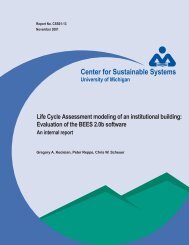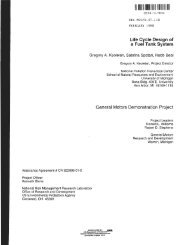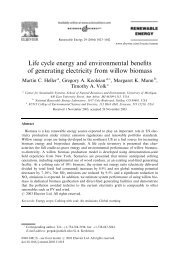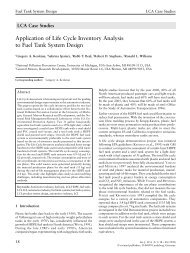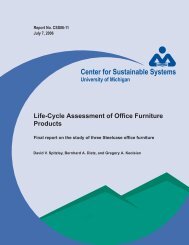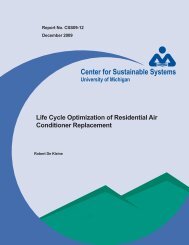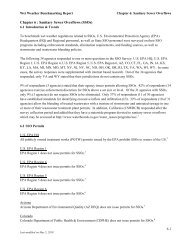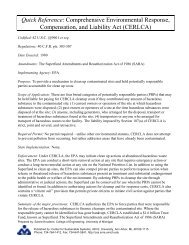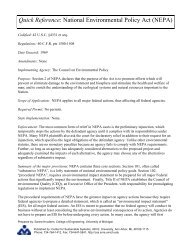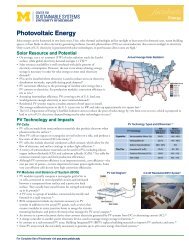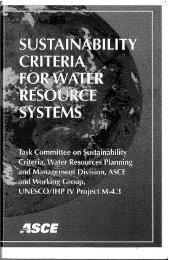A Life Cycle Assessment of the PureCell Stationary Fuel Cell System ...
A Life Cycle Assessment of the PureCell Stationary Fuel Cell System ...
A Life Cycle Assessment of the PureCell Stationary Fuel Cell System ...
- No tags were found...
Create successful ePaper yourself
Turn your PDF publications into a flip-book with our unique Google optimized e-Paper software.
Chapter 1 – Introduction<br />
More people are becoming conscious <strong>of</strong> <strong>the</strong> fact that our non-renewable energy resources<br />
are declining, and that we <strong>the</strong>refore have to switch to (more) renewable resources to<br />
satisfy our energy demand. In 2003 only 8% <strong>of</strong> <strong>the</strong> world primary energy production<br />
came from renewable sources [1]. A technology that is currently seen as a possible<br />
contribution to solve this problem and that has been subject to increasing support is fuel<br />
cell technology. <strong>Fuel</strong> cells have <strong>the</strong> potential to cover a large market, since <strong>the</strong><br />
opportunities include stationary, mobile and portable applications.<br />
<strong>Fuel</strong> cell stacks generally use hydrogen as a fuel (although <strong>the</strong>re also exist o<strong>the</strong>r possible<br />
fuel types), which is at present produced through steam reforming <strong>of</strong> natural gas. Since<br />
natural gas is a non-renewable energy resource – with <strong>the</strong> exception <strong>of</strong> small volumes<br />
harvested from landfills and anaerobic digesters – one should realize that today’s fuel<br />
cells are non-renewable energy systems. However, <strong>the</strong>y still have a better environmental<br />
performance when compared with conventional power plants [2]. Fur<strong>the</strong>rmore, both <strong>the</strong><br />
promise <strong>of</strong> steam reforming <strong>of</strong> natural gas with carbon sequestration and <strong>of</strong> an emerging<br />
hydrogen economy in which an increasing share <strong>of</strong> <strong>the</strong> hydrogen is produced by<br />
renewable resources will only enhance <strong>the</strong> environmental performance <strong>of</strong> fuel cells.<br />
The fuel cell system that is assessed in this report is UTC Power’s <strong>Pure<strong>Cell</strong></strong> Model 200<br />
Power Solution system (formerly <strong>the</strong> PC25), a 200 kW stationary phosphoric acid fuel<br />
cell. The <strong>Pure<strong>Cell</strong></strong> system has an internal natural gas steam reforming system. Since<br />
1991, more than 275 <strong>Pure<strong>Cell</strong></strong> power systems have been sold, with various applications<br />
including a New York City police station and a major postal facility in Alaska. The<br />
standard <strong>Pure<strong>Cell</strong></strong> system is a grid-connected unit that operates in parallel with <strong>the</strong><br />
electric utility grid. The unit can also be purchased to operate ei<strong>the</strong>r in grid-connected or<br />
grid-independent mode switching between modes automatically or on command. The<br />
<strong>Pure<strong>Cell</strong></strong> system is a source <strong>of</strong> reliable and assured power, and it can <strong>the</strong>refore be used<br />
as a back-up power system or as a power source for remote locations.<br />
<strong>Pure<strong>Cell</strong></strong> power systems also have <strong>the</strong> option <strong>of</strong> heat recovery. A standard <strong>Pure<strong>Cell</strong></strong><br />
power system is equipped with a <strong>the</strong>rmal management system that provides up to 925,000<br />
Btu/hr at 140 degrees Fahrenheit (equal to 271 kW at 60 degrees Celsius). There is also a<br />
high grade heat recovery option that provides up to 475,000 Btu/hr at up to 250 degrees<br />
Fahrenheit (equal to 139 kW at 121 degrees Celsius) [3]. Whereas <strong>the</strong> electrical<br />
efficiency <strong>of</strong> <strong>the</strong> <strong>Pure<strong>Cell</strong></strong> system is close to 40% based on lower heating value (LHV),<br />
<strong>the</strong> total efficiency with heat recovery exceeds 80%.<br />
UTC is in <strong>the</strong> process <strong>of</strong> redesigning <strong>the</strong> system and would value having a <strong>Life</strong> <strong>Cycle</strong><br />
<strong>Assessment</strong> (LCA) highlight opportunities for improvement when regarding its<br />
environmental performance. LCA is a systematic analysis <strong>of</strong> product life cycles from an<br />
environmental point <strong>of</strong> view. It was developed into an ISO-standard (<strong>the</strong> ISO 14040-<br />
series) in <strong>the</strong> late 1990’s [4]. An LCA can clarify which stages in <strong>the</strong> product life cycle<br />
11



